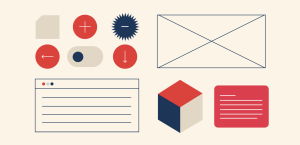
In the world of design, creating consistent, visually appealing, and user-friendly products is paramount. This is where design systems emerge as the unsung heroes of design, orchestrating harmony and efficiency in the creative process. This comprehensive article unravels the intricacies of design systems, delving deep into their significance, components, and profound impact on fostering a seamless and user-centric design experience. Whether you’re a seasoned designer looking to streamline your work or an enthusiast curious about the inner workings of the design world, this journey into the realm of design systems promises to enlighten and inspire.
The Essence of Design Systems
At its core, a design system is a comprehensive set of guidelines, principles, and assets that serve as the bedrock of consistency in design. These systems play a pivotal role in establishing and maintaining uniformity in design decisions, ensuring that every element within a product adheres to the same visual and functional rules. Their significance cannot be overstated:
Consistency
Design systems are the custodians of consistency, guaranteeing that every facet of a product, from typography to color schemes and UI elements, adheres to the predefined guidelines. This consistency forms the bedrock of a unified brand identity. Consistency reduces cognitive load for users, making it easier for them to navigate and understand the interface, which in turn leads to improved user satisfaction and loyalty. Moreover, it facilitates collaboration among designers and developers, as they work from a shared foundation, reducing the risk of design fragmentation and inconsistencies. In essence, consistency is the secret sauce that transforms a disparate set of design elements into a cohesive and memorable user experience.
Efficiency
In the fast-paced world of design, time is of the essence. Design systems come to the rescue by offering a treasure trove of reusable components and patterns, effectively saving designers valuable time and effort. By providing a comprehensive library of pre-designed components, templates, and guidelines, design systems enable designers to work smarter, not harder. This wealth of reusable assets streamlines the design process, allowing designers to focus on innovation and solving unique challenges rather than reinventing the wheel with every project.
Scalability
A well-structured design system is agile and capable of accommodating growth and evolution as products expand and embrace new functionalities. Scalability involves modular components and guidelines that can be easily extended or modified without disrupting the overall system. It also supports the expansion into various platforms and devices, ensuring that the user experience remains cohesive and intuitive across all touchpoints. This adaptability not only saves time and resources but also future-proofs the design system, making it a valuable asset for long-term product development.
User-Centric
At their core, design systems are committed to placing users’ needs at the forefront. This user-centric approach ensures that products are not just visually pleasing but also intuitive and easy to navigate. A user-centric design system promotes accessibility, ensuring that products are usable by individuals with diverse abilities. It’s a philosophy that goes beyond aesthetics, embracing empathy and usability as guiding principles to create digital experiences that truly resonate with and serve the people who use them.
Components of a Design System
To fully grasp the essence of a design system, one must dissect its core components:
Design Principles
These overarching guidelines are the North Star that guides every design decision. They dictate the look, feel, and behavior of a product, aligning design choices with the brand’s values and objectives. By adhering to these principles, designers and developers can create products that resonate with users, effectively communicate the brand’s message, and ultimately drive success in the market.
Typography
Typography encompasses the selection of typefaces, font sizes, line heights, and other typographic elements. These components ensure consistency in how text is presented. By establishing clear typographic guidelines within a design system, designers can maintain a unified look and feel across various media and platforms, reinforcing the brand’s identity and delivering a polished and engaging user experience.
Color Palette
A well-defined color scheme, comprising primary, secondary, and accent colors, reinforces brand recognition and consistency. A carefully curated color palette is a cornerstone of effective design, and it serves multiple vital functions. These colors not only reinforce brand recognition but also promote consistency across all design assets, from websites to marketing materials.
UI Elements
The library of user interface elements such as buttons, forms, icons, and navigation menus adheres to predefined styles and interactions, making them readily available for designers.
Layout Grids
Grid systems play a pivotal role in defining how content is organized on a page, ensuring uniformity in spacing, alignment, and structure.
Design Assets
Graphic elements, images, illustrations, and icons are encompassed within design assets, each following specified usage and styling guidelines.
Interaction Patterns
Guidelines for user interactions, animations, and transitions ensure that the user experience is not just cohesive but also engaging.
Documentation
Comprehensive documentation is the glue that holds all these components together, providing clear instructions for designers and developers on how to effectively use the design system.
Advantages of Design Systems
The advantages of embracing design systems within the design workflow are profound:
Streamlined Collaboration
Design systems serve as a common language and reference point, fostering collaboration between designers and developers. This shared foundation expedites the design and development process.
Faster Iteration
By offering reusable components and patterns, design systems enable quicker iterations, allowing designers to respond rapidly to changing project requirements.
Brand Consistency
Maintaining a consistent brand identity across diverse touchpoints becomes effortless with the implementation of design systems.
Improved User Experience
Prioritizing user needs and best practices through design systems results in products that are not just visually appealing but also intuitive and user-friendly.
Implementing a Design System
Creating a design system is a meticulously planned process that involves several key steps:
Research
A deep understanding of the brand, target audience, and product objectives forms the foundation of a design system. Identifying existing design elements that require consistency is a crucial step in this phase.
Define Guidelines
With a firm grasp of the brand’s essence, it’s time to establish design principles, typography rules, color palettes, and UI components. These guidelines are comprehensively documented for future reference.
Create Assets
Armed with these guidelines, design assets and patterns that adhere to the defined principles are meticulously crafted. Accessibility to these assets is made readily available to both design and development teams.
Testing
Real-world validation is pivotal. Applying the design system to actual projects and collecting feedback ensures its effectiveness. Adjustments and refinements based on this feedback enhance the system’s efficacy.
Maintenance
Design systems are not static entities but living documents that evolve with time. Regular updates and expansions are essential to accommodate ever-evolving design needs.
Elevating Design Excellence
Design systems emerge as the backbone of effective, cohesive, and user-centric design. They empower designers and developers to craft exceptional products while maintaining brand integrity. Regardless of whether the canvas is a website, a mobile application, or any digital interface, a well-implemented design system is the secret to achieving design excellence.
Embrace the power of design systems, and witness the transformation of your creative process. With design systems, you’ll streamline your workflow, drive consistency, and deliver remarkable user experiences. These systems elevate design to an art form, one that speaks the language of both aesthetics and functionality.
Level Up Your Design Game Today!






